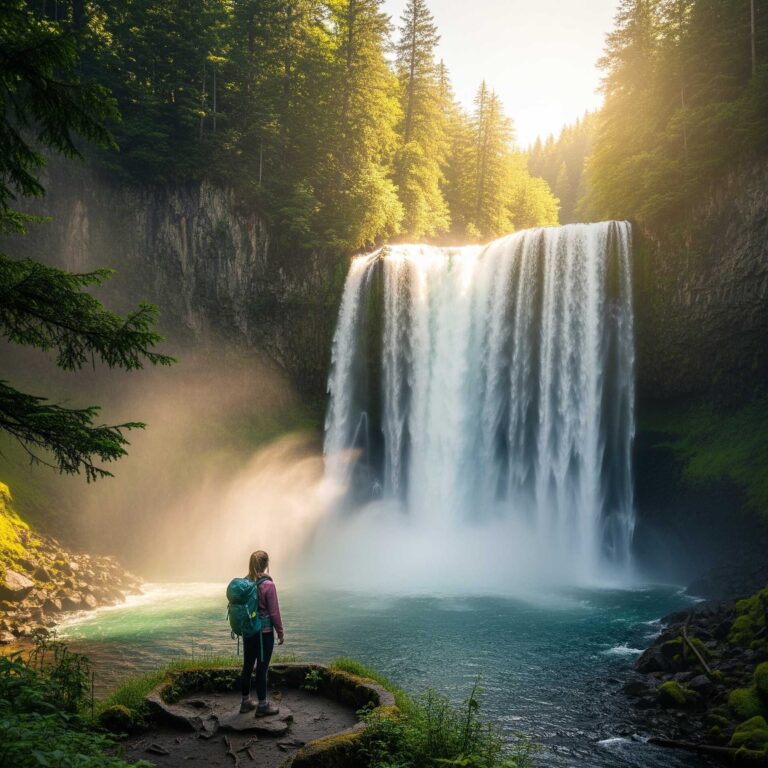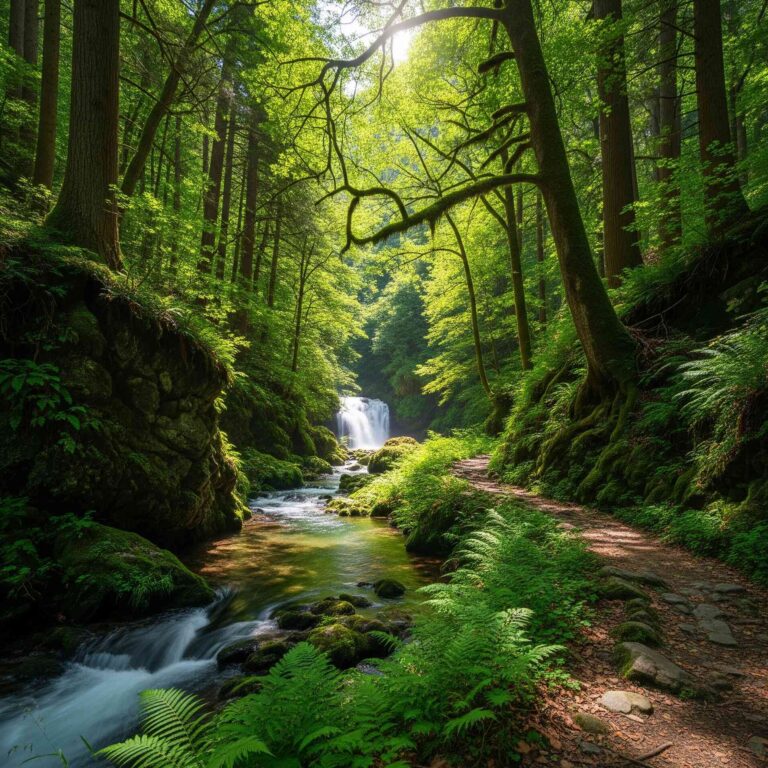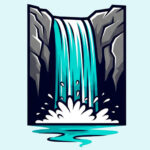Your brain feels like a browser with too many tabs open. The constant buzz of notifications, the endless to do list, the low hum of stress that never quite shuts off. Now, picture this. You are standing before a giant waterfall.
The sound is a thunder that washes away every other thought. Cool mist lands on your skin. You are not thinking about your inbox. You are just there. This shift is not magic. It is a form of natural therapy with real, science backed effects. This is your guide to understanding the powerful mental health benefits of nature, specifically the raw power of waterfalls.
We will break down the science behind why this works, give you simple ways to tap into this power, and help you find waterfalls near me.
The Calming Effect of Flowing Water on the Brain
The constant roar of a waterfall is one of nature’s purest forms of white noise. Think of the white noise of waterfalls as a bouncer for your brain. It stands at the door and blocks all the annoying, anxiety spiking sounds of traffic, notifications, and chatter from getting in.
This gives your mind the space to actually relax. The therapeutic effects of water sounds are measurable. Research shows that listening to water sounds can lead to better recovery from stress by lowering levels of cortisol, your body’s main stress hormone.
This is a clear example of how cortisol levels and nature are linked. The calming effect of flowing water directly impacts your brain’s auditory cortex and nature sounds can shift your brainwaves from high alert beta waves to relaxed alpha waves. This is one of the key physiological effects of nature. The intersection of sound therapy and nature’s soundscapes shows us this is a powerful tool for mental wellness.

The Invisible Healer: Negative Ions and Mood Enhancement
Ever notice how the air near a waterfall feels fresher, cleaner? You are not imagining it. There is a scientific reason called the Lenard effect and well being is tied to it. When water molecules crash against each other, they release tiny, invisible particles called negative ions.
Think of these water generated negative ions as airborne vitamins. You breathe them in, and they get to work. While scientists are still mapping the exact pathways, a growing body of research shows a strong link between negative ions and mood.
A 2018 review of studies found that negative ions can help regulate mood and reduce stress. The theory is that they may help your body with serotonin production in nature, which is a key chemical for happiness and well being. This makes waterfalls one of the most effective natural mood boosters available.
Awe-Inspiring Nature and the Biophilia Hypothesis
Why are we so drawn to a powerful waterfall? The answer lies in the science of biophilia. The Biophilia Hypothesis suggests that we are genetically hardwired to connect with nature because our survival depended on it for thousands of years. This deep link is a cornerstone of ecopsychology and water. Waterfalls are a prime example of awe inspiring nature.
They are so immense and powerful that they trigger a unique emotion: awe. Awe is that feeling you get when you are faced with something so vast it makes your own worries seem small. Research shows this experience reduces our focus on ourselves and promotes a feeling of connection to the bigger picture, which is a direct hit against anxiety and depression.
Even the visual texture of the water, with its endlessly repeating patterns, affects us. The brain’s response to natural fractals like those in flowing water is to relax, with some studies showing it can reduce stress by up to 60%.

Blue Space Therapy in Practice: Finding and Engaging With Local Waterfalls
Knowing the science is one thing. Experiencing it is another. Blue space therapy is about putting these principles into action. Here is how you can start your own waterfall therapy for anxiety and find some mental clarity.
How to Find Waterfalls Near Me: Your First Step to Wellness
Finding your spot is easier than you think. You do not need to plan a huge trip. Your journey to escaping to nature for mental clarity can start today.
- Use Technology: Fire up an app like AllTrails. You can filter for hiking trails with waterfalls and see reviews, difficulty, and photos from people who have already been there.
- Go Local: Check your state or national park websites. They often have maps and lists of the best waterfalls for relaxation.
- Keep it Simple: A simple search for “accessible waterfalls for mental health” or “waterfalls near me” can give you a great starting point. This is the first step in planning a wellness retreat to a waterfall.
A Simple Waterfall Meditation for Mental Clarity
Once you find your waterfall, don’t just take a picture and leave. Take 15 minutes for a waterfall meditation. These simple water based mindfulness exercises are how you absorb the benefits. This is how to practice mindfulness at a waterfall.
- Step 1 (Sight): Find a safe spot to sit or stand. Watch the water. Notice the patterns. See how the light hits the spray. The simple act of observing can be a form of nature photography and mental health.
- Step 2 (Sound): Close your eyes. Tune everything else out and focus only on the sound. Can you separate the deep roar from the higher pitched splashing? Let the sound wash over you.
- Step 3 (Feeling): Focus on the physical sensations. The cool mist on your face. The temperature of the air. The solid ground beneath your feet. This complete sensory experience of waterfalls creates deep, mindful moments in nature.
You can even use journaling prompts for nature lovers to write down what you feel, solidifying the experience. There are many guided waterfall meditations available online, but starting with your own senses is the most direct path.

Beyond Meditation: Forest Bathing and Finding Peace by Waterfalls
This whole experience is related to the Japanese practice of Shinrin-yoku, or forest bathing. Forest bathing near waterfalls is particularly powerful because it engages all your senses at once. It is the ultimate practice in reconnecting with nature. The goal is simple: finding peace by waterfalls by just being present. This is a form of adventure therapy and waterfalls offer a perfect setting.
It is a clear demonstration of the connection between physical and mental health on waterfall hikes. The physical effort to get there and the mental release you feel at the destination create a powerful combination. You begin to understand the tranquility of waterfalls on a deeper level.
This kind of hydrotherapy for mental wellness is accessible to almost everyone. The experience is so profound, it is no surprise we see waterfalls in mythology and folklore: a psychological perspective reveals they have always symbolized cleansing and renewal.
Can't Get to a Waterfall? Bringing Nature's Therapy Home
What if you are stuck in the city? You can still get many of the benefits.
- Soundscapes: High quality soundscape recordings of waterfalls are proven to help with relaxation and sleep. Put on headphones and let the sound mask the noise around you.
- Virtual Waterfalls: It might sound strange, but studies show that virtual waterfalls through VR headsets can provide real mental health benefits, reducing anxiety and improving mood. This directly answers the question, can digital nature experiences provide mental health benefits? Yes, they can.
- Home Fountains: A small indoor water feature can mimic the calming sounds and even release some of those mood boosting negative ions into your space.

Your Questions Answered (FAQ)
Let’s clear up a few common questions.
How long should I spend at a waterfall to feel the effects?
You do not need to spend all day. Research from the University of Michigan shows that just 15 to 20 minutes of immersion in a natural setting can be enough to significantly lower your cortisol levels.
What are the safety precautions when visiting local waterfalls?
Safety first, always. When you visit the waterfalls near me that you have found, stay on the marked trails. Rocks near water are incredibly slippery, even if they look dry. Never climb on or jump from a waterfall. Respect all posted signs. This is vital for the conservation of natural waterfalls as a mental health resource.
Is this a replacement for professional therapy?
No. Nature therapy is a powerful complementary practice, but it is not a substitute for professional medical advice or treatment for mental health conditions. Think of it as one tool in your wellness toolkit. It is a key component in many outdoor therapy programs and a great example of ecotherapy and its application in treating mood disorders, but it works best alongside professional guidance.
Conclusion: Your Invitation to Nature's Healing Power
Waterfalls are more than just pretty places. They are powerful, natural wellness centers. The science is clear: the combination of the sound, the water generated negative ions, and the feeling of awe creates a potent therapeutic experience.
This is nature’s healing power in action. From comparing the psychological impact of different types of water bodies, we know that the dynamic, powerful nature of waterfalls offers something unique. The impact of seasonal changes on the therapeutic qualities of waterfalls just gives you more reasons to visit year round. Now it is your turn.
Take the next step. Do a search for “waterfalls near me”. Go experience it for yourself. You might just find the mental reset you have been looking for. And when you do, we would love to hear your personal stories: how waterfalls have aided in mental health recovery.
